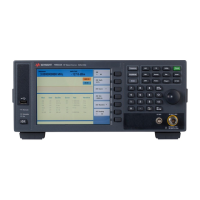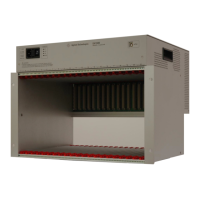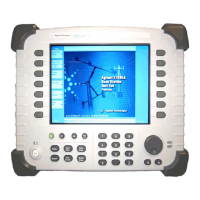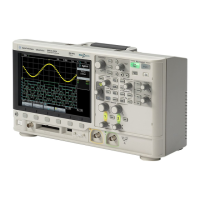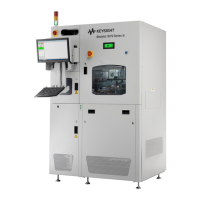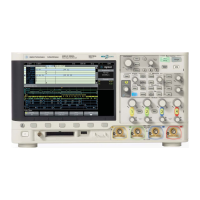4 Triggering
100 InfiniiVision 7000B Series Oscilloscopes User’s Guide
Auto Mode
Use the auto trigger modes for signals other than low-repetitive- rate
signals and for unknown signal levels. To display a DC signal, you must
use auto trigger mode since there are no edges on which to trigger.
When you select [Run], the oscilloscope operates by first filling the
pre- trigger buffer. It starts searching for a trigger after the pre- trigger
buffer is filled, and continues to flow data through this buffer while it
searches for the trigger. While searching for the trigger, the oscilloscope
overflows the pre- trigger buffer; the first data put into the buffer is the
first pushed out (FIFO). When a trigger is found, the pre- trigger buffer
will contain the events that occurred just before the trigger. If no trigger is
found, the oscilloscope generates a trigger and displays the data as though
a trigger had occurred. In this case, the background of the Auto indicator
at the top of the display will flash, and the Auto indicator will change to
Auto? indicating that the oscilloscope is forcing triggers.
When you press the [Single] key, the oscilloscope will fill pre- trigger buffer
memory, and continue flowing data through the pre- trigger buffer until
the auto trigger overrides the searching and forces a trigger. At the end of
the trace, the oscilloscope will stop and display the results.
Normal Mode
Use Normal trigger mode for low repetitive- rate signals or when Auto
trigger is not required.
In Normal mode the oscilloscope must fill the pre- trigger buffer with data
before it will begin searching for a trigger event. The trigger mode
indicator on the status line flashes Trig’d? to indicate the oscilloscope is
filling the pre- trigger buffer. While searching for the trigger, the
oscilloscope overflows the pre- trigger buffer; the first data put into the
buffer is the first pushed out (FIFO).
When the trigger event is found, the oscilloscope will fill the post- trigger
buffer and display the acquisition memory. The trigger mode indicator on
the status line indicates Trig’d (not flashing). If the acquisition was
initiated by [Run/Stop], the process repeats. If the acquisition was initiated
by pressing [Single], then the acquisition stops and you can Pan and Zoom
the waveform.
